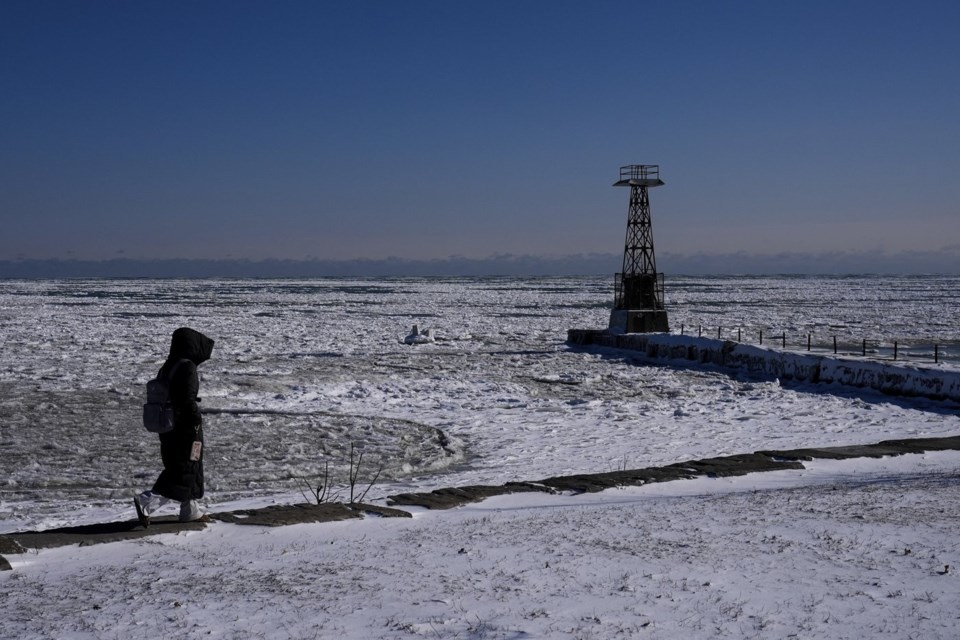The coldest burst of Arctic air this season is coming to put an icy exclamation point on America's winter of repeated polar vortex invasions, meteorologists warn. And it will stay frozen there all next week.
Different weather forces in the Arctic are combining to push the chilly air that usually stays near the North Pole not just into the United States, but also Europe, several meteorologists tell The Associated Press.
This will be the 10th time this winter that the polar vortex — which keeps the coldest of Arctic air penned in at the top of the world — stretches like a rubber band to send some of that big chill south, said Judah Cohen, seasonal forecast director at the private firm Atmospheric and Environmental Research. In a normal winter, it happens maybe two or three times.
This winter, with record snow in New Orleans and drought and destructive wildfires in Southern California, has not been normal.
The latest projected cold outbreak should first hit the northern Rockies and northern Plains Saturday and then stick around all next week. The cold will likely concentrate east of the Rockies with only the far American west and central and southern Florida exempted, meteorologists said.
On Tuesday, expect the Lower 48 states to have an average low of 16.6 degrees Fahrenheit (minus 8.6 Celsius), and then plunge to 14 degrees (minus 10 Celsius) on Wednesday, calculated private meteorologist Ryan Maue, a former National Oceanic and Atmospheric Administration chief scientist.
Sometime next week, 89% of the contiguous United States will be below the freezing mark and 27% of the Lower 48 will be below zero (minus 18 degrees Celsius), according to National Weather Service forecasts.
Meteorologists expect strong winds to make the cold feel even worse. Every U.S. state but Hawaii, California and Florida have some or all parts forecast to have a good chance of windchills of 20 degrees or below sometime next week, the National Weather Service predicted.
Kansas, Nebraska, Missouri and Iowa will have “probably the most impressive” cold, with temperatures as much as 35 degrees (19 degrees Celsius) below what's normal for this time of year, said Zack Taylor, a meteorologist at the weather service's Weather Prediction Center. NOAA weather models predict Wednesday lows below zero in Oklahoma, Colorado, Nebraska, Missouri, Illinois, Iowa, Kansas, Wyoming, Montana, North Dakota, South Dakota, Minnesota, Wisconsin and Michigan.
Some storms — with flooding, heavy snow or even a nor'easter — could hit during next week's prolonged cold outbreak, but details on those aren't certain yet, Taylor said.
“Everything, all the stars align, all the wind directions in the atmosphere are dragging the cold polar air out of the Canadian Arctic,” Maue said. “It’s the depths of winter. Everything signals extreme biting, winter cold. Obviously this isn’t the first polar vortex episode of the winter, but it looks to be the most severe.”
A stretched polar vortex like this one happens lower in the atmosphere and is different than when the polar vortex has sudden warming, weakens and all the cold air escapes south and out of the poles, Cohen said. During stretching events, the polar vortex remains in place and strong, but it also just pulls and bends. Stretch outbreaks are usually slightly milder than the big polar escape events and often hit the United States, not Europe.
Meteorologists are going to want to study why this stretching is happening so often this year, but it could just be natural randomness, said Laura Ciasto, a meteorologist at NOAA's Climate Prediction Center who specializes in the polar vortex.
“What we're observing right now is interesting, but not unprecedented,” said Martin Stendel, a scientist at the National Center for Climate Research in Denmark.
Another factor adding to the polar vortex stretching is a big blob of high pressure in the upper atmosphere over Greenland. It's moving west and will push the jet stream — the river of air that moves weather systems such as storms — into a pattern that causes polar air to plunge and stay there, Cohen said.
Human-caused climate change may be making the jet stream wavier and more likely to be stuck in that wavy pattern, one of the factors involved, Stendel said.
There haven't been many winters like this in the past to help meteorologists forecast what will happen next and when the cold will finally go away, Maue said.
Despite the unusually cold winter across the U.S., the world remains in an overall warming pattern. Earth's average overall temperature set yet another monthly heat record in January. It was the 18th month of the last 19 that the world hit or passed the internationally agreed upon warming limit of 1.5 C (2.7 F) above pre-industrial times.
___
Data journalist Mary Katherine Wildeman contributed.
___
Follow Seth Borenstein on X at @borenbears
___
Read more of AP’s climate coverage at http://www.apnews.com/climate-and-environment
___
The Associated Press’ climate and environmental coverage receives financial support from multiple private foundations. AP is solely responsible for all content. Find AP’s standards for working with philanthropies, a list of supporters and funded coverage areas at AP.org.
Seth Borenstein, The Associated Press


